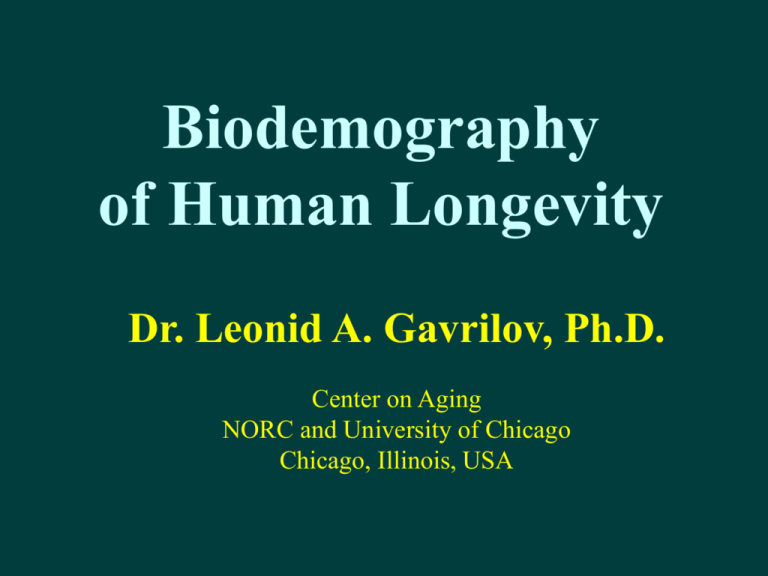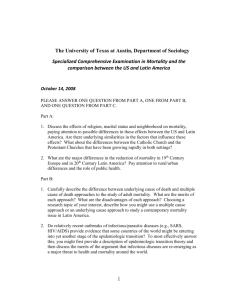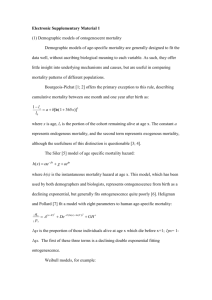here
advertisement

Biodemography of Human Longevity Dr. Leonid A. Gavrilov, Ph.D. Center on Aging NORC and University of Chicago Chicago, Illinois, USA What is Biodemography? Biodemography is a multidisciplinary approach, integrating biological knowledge (studies on human biology and animal models) with demographic research on human longevity and survival Why do we need Biodemography? Biodemographic studies are important for: • understanding the driving forces of current longevity revolution (dramatic increase in human life expectancy) • forecasting the future of human longevity • identification of new strategies for further increase in healthy and productive life span. Two Illustrative Examples of the Recent Longevity Revolution in Industrialized Countries: • France • Japan Historical Changes in Survival from Age 90 to 100 years. France Percent Surviving from Age 90 to 100 6 5 Females Males 4 3 2 1 0 1900 1920 1940 1960 Calendar Year 1980 2000 Historical Changes in Survival from Age 90 to 100 years. Japan Percent Surviving from Age 90 to 100 10 Females Males 8 6 4 2 0 1950 1960 1970 1980 Calendar Year 1990 2000 What are the representative examples of biodemograhic studies and publications? Brief history of Biodemography and brief bibliography What are the Major Biodemograhic Findings? Biodemographic studies found a remarkable similarity in survival dynamics between humans and laboratory animals. 1. Gompertz-Makeham law of mortality 2. Compensation law of mortality 3. Late-life mortality deceleration. The Gompertz-Makeham Law The Gompertz-Makeham law states that death rate is a sum of age-independent component (Makeham term) and age-dependent component (Gompertz function), which increases exponentially with age. μ(x) = A + R0exp(α x) A – Makeham term or background mortality R0exp(α x) – age-dependent mortality Exponential Increase of Death Rate with Age in Fruit Flies (Gompertz Law of Mortality) Linear dependence of the logarithm of mortality force on the age of Drosophila. Based on the life table for 2400 females of Drosophila melanogaster published by Hall (1969). Mortality force was calculated for 3-day age intervals. Source: Gavrilov, Gavrilova, “The Biology of Life Span” 1991 Age-Trajectory of Mortality in Flour Beetles (Gompertz-Makeham Law of Mortality) Dependence of the logarithm of mortality force (1) and logarithm of increment of mortality force (2) on the age of flour beetles (Tribolium confusum Duval). Based on the life table for 400 female flour beetles published by Pearl and Miner (1941). Mortality force was calculated for 30day age intervals. Source: Gavrilov, Gavrilova, “The Biology of Life Span” 1991 Age-Trajectory of Mortality in Italian Women (Gompertz-Makeham Law of Mortality) Dependence of the logarithm of mortality force (1) and logarithm of increment of mortality force (2) on the age of Italian women. Based on the official Italian period life table for 1964-1967. Mortality force was calculated for 1-year age intervals. Source: Gavrilov, Gavrilova, “The Biology of Life Span” 1991 The Compensation Law of Mortality The Compensation law of mortality (late-life mortality convergence) states that the relative differences in death rates between different populations of the same biological species are decreasing with age, because the higher initial death rates are compensated by lower pace of their increase with age Compensation Law of Mortality Convergence of Mortality Rates with Age 1 – India, 1941-1950, males 2 – Turkey, 1950-1951, males 3 – Kenya, 1969, males 4 - Northern Ireland, 1950-1952, males 5 - England and Wales, 19301932, females 6 - Austria, 1959-1961, females 7 - Norway, 1956-1960, females Source: Gavrilov, Gavrilova, “The Biology of Life Span” 1991 Compensation Law of Mortality in Laboratory Drosophila 1 – drosophila of the Old Falmouth, New Falmouth, Sepia and Eagle Point strains (1,000 virgin females) 2 – drosophila of the Canton-S strain (1,200 males) 3 – drosophila of the Canton-S strain (1,200 females) 4 - drosophila of the Canton-S strain (2,400 virgin females) Mortality force was calculated for 6day age intervals. Source: Gavrilov, Gavrilova, “The Biology of Life Span” 1991 The Late-Life Mortality Deceleration (Mortality Leveling-off, Mortality Plateaus) • The late-life mortality deceleration law states that death rates stop to increase exponentially at advanced ages and level-off to the late-life mortality plateau. • An immediate consequence from this observation is that there is no fixed upper limit to human longevity - there is no special fixed number, which separates possible and impossible values of lifespan. • This conclusion is important, because it challenges the common belief in existence of a fixed maximal human life span. Mortality at Advanced Ages Source: Gavrilov L.A., Gavrilova N.S. The Biology of Life Span: A Quantitative Approach, NY: Harwood Academic Publisher, 1991 M. Greenwood, J. O. Irwin. BIOSTATISTICS OF SENILITY Survival Patterns After Age 90 Percent surviving (in log scale) is plotted as a function of age of Swedish women for calendar years 1900, 1980, and 1999 (cross-sectional data). Note that after age 100, the logarithm of survival fraction is decreasing without much further acceleration (aging) in almost a linear fashion. Also note an increasing pace of survival improvement in history: it took less than 20 years (from year 1980 to year 1999) to repeat essentially the same survival improvement that initially took 80 years (from year 1900 to year 1980). Source: cross-sectional (period) life tables at the Berkeley Mortality Database (BMD): http://www.demog.berkeley.edu/~bmd/ Non-Gompertzian Mortality Kinetics of Four Invertebrate Species Non-Gompertzian mortality kinetics of four invertebrate species: nematodes, Campanularia flexuosa, rotifers and shrimp. Source: A. Economos. A non-Gompertzian paradigm for mortality kinetics of metazoan animals and failure kinetics of manufactured products. AGE, 1979, 2: 74-76. Non-Gompertzian Mortality Kinetics of Three Rodent Species Non-Gompertzian mortality kinetics of three rodent species: guinea pigs, rats and mice. Source: A. Economos. A non-Gompertzian paradigm for mortality kinetics of metazoan animals and failure kinetics of manufactured products. AGE, 1979, 2: 74-76. Mortality Leveling-Off in Drosophila Non-Gompertzian mortality kinetics of Drosophila melanogaster Source: Curtsinger et al., Science, 1992. Non-Gompertzian Mortality Kinetics of Three Industrial Materials Non-Gompertzian mortality kinetics of three industrial materials: steel, industrial relays and motor heat insulators. Source: A. Economos. A non-Gompertzian paradigm for mortality kinetics of metazoan animals and failure kinetics of manufactured products. AGE, 1979, 2: 74-76. Aging is a Very General Phenomenon! What Should the Aging Theory Explain: • Why do most biological species deteriorate with age? • Specifically, why do mortality rates increase exponentially with age in many adult species (Gompertz law)? • Why does the age-related increase in mortality rates vanish at older ages (mortality deceleration)? • How do we explain the so-called compensation law of mortality (Gavrilov & Gavrilova, 1991)? Redundancy Creates Both Damage Tolerance and Damage Accumulation (Aging) Damage Defect No redundancy Death Damage Defect Redundancy Damage accumulation (aging) Differences in reliability structure between (a) technical devices and (b) biological systems Each block diagram represents a system with m serially connected blocks (each being critical for system survival, 5 blocks in these particular illustrative examples) built of n elements connected in parallel (each being sufficient for block being operational). Initially defective non-functional elements are indicated by crossing (x). The reliability structure of technical devices (a) is characterized by relatively low redundancy in elements (because of cost and space limitations), each being initially operational because of strict quality control. Biological species, on the other hand, have a reliability structure (b) with huge redundancy in small, often non-functional elements (cells). Statement of the HIDL hypothesis: (Idea of High Initial Damage Load ) "Adult organisms already have an exceptionally high load of initial damage, which is comparable with the amount of subsequent aging-related deterioration, accumulated during the rest of the entire adult life." Source: Gavrilov, L.A. & Gavrilova, N.S. 1991. The Biology of Life Span: A Quantitative Approach. Harwood Academic Publisher, New York. Why should we expect high initial damage load ? • General argument: -- In contrast to technical devices, which are built from pretested high-quality components, biological systems are formed by self-assembly without helpful external quality control. • Specific arguments: 1. Cell cycle checkpoints are disabled in early development (Handyside, Delhanty,1997. Trends Genet. 13, 270-275 ) 2. extensive copy-errors in DNA, because most cell divisions responsible for DNA copy-errors occur in early-life (loss of telomeres is also particularly high in early-life) 3. ischemia-reperfusion injury and asphyxia-reventilation injury during traumatic process of 'normal' birth Spontaneous mutant frequencies with age in heart and small intestine Small Intestine Heart 35 -5 Mutant frequency (x10 ) 40 30 25 20 15 10 5 0 0 5 10 15 20 Age (months) 25 30 35 Source: Presentation of Jan Vijg at the IABG Congress, Cambridge, 2003 Birth Process is a Potential Source of High Initial Damage • During birth, the future child is deprived of oxygen by compression of the umbilical cord and suffers severe hypoxia and asphyxia. Then, just after birth, a newborn child is exposed to oxidative stress because of acute reoxygenation while starting to breathe. It is known that acute reoxygenation after hypoxia may produce extensive oxidative damage through the same mechanisms that produce ischemiareperfusion injury and the related phenomenon, asphyxia-reventilation injury. Asphyxia is a common occurrence in the perinatal period, and asphyxial brain injury is the most common neurologic abnormality in the neonatal period that may manifest in neurologic disorders in later life. Practical implications from the HIDL hypothesis: "Even a small progress in optimizing the early-developmental processes can potentially result in a remarkable prevention of many diseases in later life, postponement of aging-related morbidity and mortality, and significant extension of healthy lifespan." "Thus, the idea of early-life programming of aging and longevity may have important practical implications for developing earlylife interventions promoting health and longevity." Source: Gavrilov, L.A. & Gavrilova, N.S. 1991. The Biology of Life Span: A Quantitative Approach. Harwood Academic Publisher, New York. Season of Birth and Female Lifespan 8,284 females from European aristocratic families born in 1800-1880 Seasonal Differences in Adult Lifespan at Age 30 3 • Life expectancy of adult women (30+) as a function of month of birth (expressed as a difference from the reference level for those born in February). • The data are point estimates (with standard errors) of the differential intercept coefficients adjusted for other explanatory variables using multivariate regression with categorized nominal variables. p=0.006 Lifespan Difference (yr) p=0.02 2 1 0 FEB MAR APR MAY JUN JUL AUG SEP OCT NOV DEC JAN FEB. Month of Birth Failure Kinetics in Mixtures of Systems with Different Redundancy Levels Initial Period The dependence of logarithm of mortality force (failure rate) as a function of age in mixtures of parallel redundant systems having Poisson distribution by initial numbers of functional elements (mean number of elements, = 1, 5, 10, 15, and 20. Strategies of Life Extension Based on the Reliability Theory Increasing redundancy Maintenance and repair Increasing durability of components Replacement and repair Conclusions (I) • Redundancy is a key notion for understanding aging and the systemic nature of aging in particular. Systems, which are redundant in numbers of irreplaceable elements, do deteriorate (i.e., age) over time, even if they are built of nonaging elements. • An actuarial aging rate or expression of aging (measured as age differences in failure rates, including death rates) is higher for systems with higher redundancy levels. Conclusions (II) • Redundancy exhaustion over the life course explains the observed ‘compensation law of mortality’ (mortality convergence at later life) as well as the observed late-life mortality deceleration, leveling-off, and mortality plateaus. • Living organisms seem to be formed with a high load of initial damage, and therefore their lifespans and aging patterns may be sensitive to early-life conditions that determine this initial damage load during early development. The idea of early-life programming of aging and longevity may have important practical implications for developing early-life interventions promoting health and longevity. Acknowledgments This study was made possible thanks to: • generous support from the National Institute on Aging, and • stimulating working environment at the Center on Aging, NORC/University of Chicago For More Information and Updates Please Visit Our Scientific and Educational Website on Human Longevity: • http://longevity-science.org







